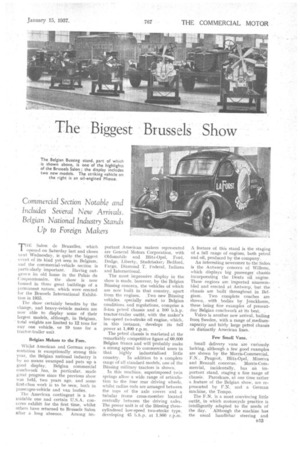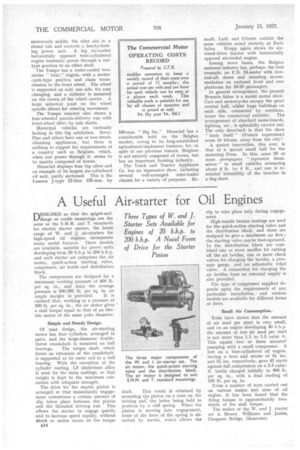The Biggest Brussels Show
Page 47

Page 48

If you've noticed an error in this article please click here to report it so we can fix it.
Commercial Section Notable and Includes SeVeral New Arrivals. Belgian National Industry Stands Up to Foreign Makers THE Salon de Bruxelles, which opened on Saturday last and closes next Wednesday, is quite the biggest event of its kind yet seen in Belgium, and the commercial-vehicle section is particularly important. Having outgrown its old home in the Palais du Cinquantenaire, the show is now housed in three great buildings of a permanent nature, which were erected fur the Brussels International Exhibition in 1935.
The show certainly benefits by the change, and heavy-vehicle makers are now able to display some of their largest models, although, in Belgium. total weights are limited to 12 tons for any one vehicle, vr 19 tons for a tractor-trailer unit.
Belgian Makers to the Fore.
Whilst American and German representation is exceptionally strong this • year, the Belgian national industry is by no means swamped and puts up a good display. Belgian commercial coachwork .has, in particular, made great progress since the previous show was held, two years ago, and some first-class work is to be seen, both in passenger-vehicle and van bodies.
The American contingent is a formidable one and certain U.S.A. concerns exhibit for the first time, whilst others have returned to Brussels Salon after a long absence. Among im
portant American makers represented are General Motors Corporation, with Oldsmobile and Blitz-Opel, Ford, Dodge, Liberty, Studebaker; Bedford, Fargo, Diamond T, Federal, Indiana and International.
The most impressive display in the show is made, however, by the Belgian Bussing concern, the vehicles of which are now built in that country, apart from the engines. Two new Bussing vehicles, specially suited to Belgian conditions and regulations, comprise a 3-ton petrol chassis and a 100 b.h.p. tractor-trailer outfit, with the maker's low-speed two-stroke oil engine i which, in this instance, develops its full power at 1,400 r.p.m.
The petrol chassis is marketed at the remarkably competitive figure of 60,000 Belgian francs and will 'probably make a strong appeal te commercial users in that highly industrialized little country. In addition to a complete range of all standard models; one of the Bussing military tractors is shown.
In this machine, superimposed twin springs allow a wide range of articulation to the four rear driving wheels, whilst radius rods are arranged between the tops of the axle covers and a tubular frame cross-member located centrally between the driving axles. The power unit is of the Bussing threecylindered low-speed two-stroke type, developing 45 h.h.p. at 1,800 r.p.m. A feature of this stand is the staging of a full range of engines, both petrol and oil, produced by the company.
An interesting newcomer to the Salon is the Antwerp concern of Willems, which displays big passenger chassis incorporating the Deutz oil engine These engines are imported unassembled and erected at Antwerp, bpt the chassis are built throughout in Belgium. Two complete coaches are shown, with bodies by Joiickheere, these being fine examples of presentday Belgian coachwork at its best,..
Volvo Volvo is another new arrival, hailing from Sweden, with a range ef..mediumcapacity and fairly large petrol chassis on distinctly American lines.
Few Small Vans. • Small delivery vans are curiously lacking, although a few good examples are shown by the Morris-Commercial, F.N., Peugeot, Blitz-Opel, Minerva and Renault concerns. Morris-Coramercial, incidentally, has an important stand, staging a fine range of chassis. Parcekars, at one time rather a feature of the Belgian show, are represented by F.N. and a German machine, the Tempo.
The F.N. is a most convincing little outfit, in which motorcycle practice is intelligently adapted to the needs of the day. Although the machine has the usual handlebar steering and
motorcycle saddle, the rider sits in a closed cab and controls a hearty-looking power unit. A big, air-cooled horizontally opposed twin-cylindered engine transmits power through a cartype gearbox to an offset shaft.
The Tempo has a water-cooled twostroke "twin " engine, with a motorcycle-type gearbox and chain transmission to the front wheel. The wheel is supported on only one side, for easy changing, and a radiator is mounted on the crown_ of the wheel carrier. A large spherical joint on the wheel spindle allows for steering movement.
The Tempo concern also shows a four-wheeled parcels-delivery van with front-wheel drive by side shafts.
Municipal vehicles are curiously lacking in this big exhibition. BovyPipe and others have one or two streetcleansing appliances, but there is nothing to suggest the requirements of a country such as Belgium, which, when one passes through it, seems to be mainly composed of towns.
Henschel displays four big oilers and an example of its largest six-cylindered oil unit, partly sectioned. This is the Lanova J-type I2-litre 125-mm. by 160-mm. " Big Six." Henschel has a considerable hold on the Belgian market, owing to its long-established agricultural-implement business, for, in spite of our previous remark, Belgium is not entirely composed of towns, but has an important fanning industry.
The Truck and Tractor Appliance Co. has an impressive show, including several well-arranged semi-trailer chassis for a variety of purposes. Re
nault, Lath and Citroen exhibit the same vehicles noted recently at Paris
Salon. Krupp again shows its sixwheel-drive tractor with horizontally opposed air-cooled engine.
Among town buses, the Belgian national industry has, perhaps, the best example, an F.N. 24-seater with foreand-aft doors and standing accommodation on enclosed front and rear platforms for 16-20 passengers.
In general arrangement, the present Brussels Salon is a model motor show. Cars and motorcycles occupy the great central hall, whilst huge buildings on each side, connected by corridors, house the commercial exhibits. The arrangement of standard name-boards, lighting, etc., is splendidly carried out. The only drawback is that the show " finds itself" (French expression) some 10 kiloms. away from the city A quaint innovation, this year, is that of a special small hall for the motoring Press. In this, some 20 or more newspapers " represent themselves" in small cubicles measuring about 4 ft. by 4 ft., and one is reminded irresistibly of the benches in a dog show.




















































































